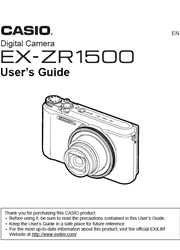The LCD opens up 180° so you can check your self-portraits as you shoot. It shoots from a variety of angles, letting you get just the right composition. And its built-in camera stand lets you shoot hands-free. Enjoy shooting self-portraits in all kinds of poses.
Quick Start Basics
What you can do with your CASIO camera
Tilting the Monitor Screen
Using the Stand
First, charge the battery prior to use.
Configuring Basic Settings the First Time You Turn On the Camera
Preparing a Memory Card
Turning the Camera On and Off
Holding the Camera Correctly
To shoot a snapshot
Viewing Snapshots
Deleting Snapshots and Movies
Snapshot Shooting Precautions
Snapshot Tutorial
Selecting the Recording Mode
Using the Control Panel
Using the Self-timer (Self-timer)
Adjusting White Balance (White Balance)
Selecting a Focus Mode (Focus)
Specifying ISO Sensitivity (ISO)
Recording Beautiful Portraits (Smooth Skin)
Correcting Image Brightness (EV Shift)
Using Flash (Flash)
Specifying the Metering Mode (Metering)
Shooting with Zoom
Triggering a Self-timer Operation with Motion (Handsfree)
Shooting with Artistic Effects (ART SHOT)
Shooting with Triple Shot
Recording Movies
To record a movie
Recording a High-definition Movie
Recording a High Speed Movie
Using Prerecord Movie (Prerecord (Movie))
Recording a Time Lapse Movie (Time Lapse)
Shooting a Snapshot while Shooting a Movie (Snapshot In Movie)
Using BEST SHOT
To shoot with BEST SHOT
Creating and Using Your Own Setups (CUSTOM SHOT)
Shooting with a Face Brightening Effect (Make-up)
Shooting with High Speed Anti Shake (HS Anti Shake)
Shooting Bright Images in the Dark without Flash (HS Night Shot)
Digitally Correcting for Overexposure and Underexposure (HDR)
Shooting with a Blurred Background (Blurred Background)
Shooting with Full Focus Macro (All-In-Focus Macro)
Using Continuous Shutter with Auto Focus (AF-CS)
Shooting a Burst of Images (High Speed CS)
Shooting with Priority on Subject Faces (HS Best Selection)
Shooting a Panorama Image (Slide Panorama)
Shooting with a Super Wide Angle of View (Wide Shot)
Shooting Snapshots (Snapshot)
Shooting RAW Images (Raw Image)
Using a TV Screen to Shoot Snapshots (HDMI TV Output)
Advanced Settings (REC MENU)
Configuring Recording Settings
Configuring Handsfree Settings (Handsfree)
Configuring Motion Position Settings (Motion Position)
Assigning Functions to the Control Dial (Control Dial)
Assigning Functions to the [<] and [>] Keys (L/R Key)
Saving a Second Normal Image When Shooting With HDR Art (Double (HDR ART))
To select the snapshot image size (Image Size)
Specifying Snapshot Image Quality (Image Quality)
Movie Image Quality Settings (Movie Quality)
Specifying ISO Sensitivity (ISO)
Specifying the ISO Sensitivity Upper Limit (ISO High Limit)
Reducing the Effects of Camera and Subject Movement (Anti Shake)
Zooming with Super Resolution (Zoom (SR))
Turning Digital Zoom On or Off (Digital Zoom)
Selecting a Focus Mode (Focus)
Shooting with Face Detection (Face Detection)
Specifying the Auto Focus Area (AF Area)
Recording Beautiful Portraits (Smooth Skin)
Shooting with Continuous Auto Focus (Continuous AF)
Optimizing Image Brightness (Lighting)
Reducing Wind Noise during Movie Recording (Wind Noise Cut)
Correcting Image Brightness (EV Shift)
Adjusting White Balance (White Balance)
Using the Self-timer (Self-timer)
Specifying the Metering Mode (Metering)
Specifying Flash Intensity (Flash Intensity)
Controlling Image Sharpness (Sharpness)
Controlling Color Saturation (Saturation)
Adjusting Image Contrast (Contrast)
Using the Auto Focus Assist Light (AF Assist Light)
Turning on Image Review (Review)
Using Icon Help (Icon Help)
Changing the Monitor Screen when Recording (Shooting Info)
Configuring Power On Default Settings (Memory)
Viewing Snapshots and Movies
Viewing Snapshots
Viewing a Movie
Viewing a Panorama Image
Viewing Continuous Shutter Images
Scrolling Images at High Speed or by Recording Date
Zooming an On-screen Image
Displaying the Image Menu
Viewing Snapshots and Movies on a TV Screen
Other Playback Functions (PLAY MENU)
Playing a Slideshow on the Camera (Slideshow)
Editing a Movie on the Camera (Movie Editing)
To merge two movies (Movie Merge)
Creating a Snapshot of Movie Frames (MOTION PRINT)
Optimizing Image Brightness (Lighting)
Adjusting White Balance (White Balance)
Adjusting the Brightness of an Existing Snapshot (Brightness)
Selecting Images for Printing (DPOF Printing)
Protecting a File Against Deletion (Protect)
Editing the Date and Time of an Image (Date/Time)
Rotating an Image (Rotation)
Resizing a Snapshot (Resize)
Cropping a Snapshot (Trimming)
Copying Files (Copy)
Combining CS Images into a Single Still Image (CS Multi Print)
Dividing Up a Continuous Shutter Group (Divide Group)
Editing a Image (Edit Group)
Printing
Printing Snapshots
Using DPOF to Specify Images to be Printed and the Number of Copies (DPOF Printing)
Using the Camera with a Computer
Things you can do using a computer
Using the Camera with a Windows Computer
Using the Camera with a Macintosh
Using an SD Memory Card with Built-in LAN
Files and Folders
Memory Card Data
Other Settings (SETTING)
Enabling Power Saving (ECO Mode)
Adjusting Monitor Screen Brightness (Screen)
Turning off Eye-Fi Card Communication (Eye-Fi)
Configuring FlashAir Card Communication Settings (FlashAir)
Configuring Camera Sound Settings (Sounds)
Creating an Image Storage Folder (Create Folder)
Time Stamping Snapshots (Timestamp)
Auto Image Orientation Detection and Rotation (Auto Rotate)
Specifying the File Name Serial Number Generation Rule (File No.)
Configuring Sleep State Settings (Sleep)
Configuring Auto Power Off Settings (Auto Power Off)
Specifying the Operation when the Monitor Screen is Tilted (Screen Tilt)
Configuring [>] Setting (PLAY)
Disabling File Deletion (Delete Key)
Configuring World Time Settings (World Time)
Setting the Camera’s Clock (Adjust)
Specifying the Date Style (Date Style)
Specifying the Display Language (Language)
Selecting the Screen Aspect Ratio and Video Output System (Video Output)
Selecting the HDMI Terminal Output Method (HDMI Output)
Formatting Built-in Memory or a Memory Card (Format)
Resetting the Camera to Factory Defaults (Reset)
Appendix
Safety Precautions
Precautions During Use
Power Supply
Using a Memory Card
Reset Initial Default Settings
When things don’t go right
Number of Snapshots/Movie Recording Time
Specifications
